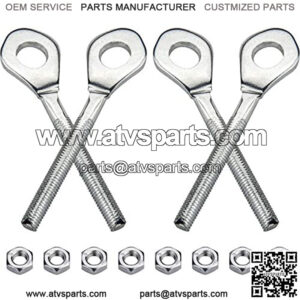HOW TO TIGHTEN A CHAIN ON AN ATV
Picture this: You’re cruising down the trail on your quad. You’re blasting the latest Swift jams and loving the freedom of the outdoors. Then, kablammo! Your ATV stops and your chain is laying on the ground. You really should’ve learned how to tighten the chain on your ATV before you blew it. At least you’ve still got Taylor.
That hasn’t happened to you yet (we hope), and we’re here to make sure it doesn’t. We’ll also give you a few extra pointers to make sure your ATV’s chain is off the chain and running smooth.
WHAT TO CONSIDER BEFORE TIGHTENING THE ATV’S CHAIN
First of all, are you even sure you need to tighten your ATV chain? Overtightening your chain can cause just as many problems as undertightening.
SYMPTOMS OF A LOOSE CHAIN
Let’s look at the symptoms of a loose chain:
- Jerky feeling when you accelerate due to slack
- Power loss and clicking noise from the chain skipping over sprocket teeth
- Your chain falls off mid-ride
If you notice any of these things happening while you ride, you need to tighten your chain ASAP. In fact, you shouldn’t let your chain get this bad in the first place.
Instead, you should compare the slack in your chain to your manuals guidelines before it gets bad. Once you start noticing these issues, you’ve already subjected your drivetrain and sprockets to excessive wear and tear.
SYMPTOMS OF AN OVERTIGHT CHAIN
You might be experiencing some issues that you’re pretty sure are chain related, but it might be because your chain is too tight.
Having a too-tight chain can cause:
- Excess wear on your sprockets and drivetrain
- Less rear suspension travel
- Power loss
So don’t just assume your chain problems are due to a loose chain. Improper maintenance and overtightening can cause similar drivetrain issues. Check your manual and measure your slack to see what your chain needs.
HOW TO TIGHTEN THE CHAIN
In order to tighten the chain on an ATV, you just need a few wrenches or sockets, a measuring tape, and, for some ATVs, a screwdriver.
Here is how to tighten the chain on your ATV.
1. MEASURE THE SLACK IN YOUR CHAIN
- Check the factory recommended slack in your user manual (usually 1-1.5 inches)
- Have somebody sit on the ATV to simulate the tension the chain normally sees
- Place the end of your tape measure flat on the skid plate or chain guard near the center of the swing arm
- Note the measurement where the chain rests naturally, then pull up on the chain and note it’s measure at it’s highest point
- Take the difference of those measurements to get your chains slack
Now that you know how much slack is in your chain, you know if it’s actually too loose or if you’ve got some other issues going on.
2. TIGHTEN YOUR ATV CHAIN
- Loosen, but don’t remove the bolts on the bearing carrier at the rear of your machine
- Find the adjuster bolt or bolts and loosen the jam nuts
- Tighten the adjuster bolts to tighten the chain
- With weight on the ATV, take measurements of your slack and make adjustments until it’s in the appropriate range
- Tighten all of your hardware and jam nuts
If you don’t have adjuster bolts, the process is a little bit different:
- Loosen, but don’t remove the bolts on the bearing carrier at the rear of your machine
- Find the hole that allows you to slip a screwdriver or allen key through the carrier and sprocket
- Rotate the rear wheels forward to tighten—with the allen key in place, this will rotate the entire bearing carrier and move the centerline backwards
- With weight on the ATV, take measurements of your slack and make adjustments until it’s in the appropriate range
- Tighten all of your hardware
That’s it. Easy peasy. Your first time should only take you a few minutes as long as there’s not too much dirt or rust keeping your bolts tight. After doing it a few times, you’ll be a chain tightening master.
HOW TO CHANGE THE CHAIN
Sometimes tightening your ATV chain isn’t enough. Sometimes that chain is kaput and it’s time to say, “see ya!” and toss it in the trash. But how can you tell?
There are a couple telltale signs: rust and stretching.
Rust is the enemy of your chain. If your chain is rocking that dusty red patina, don’t bother cleaning it up. You need to replace it. It means your chain is weak, and it likely has some damage to it already. Sooner or later, your rusty chain is gonna break. Ditch it for a new one.
Stretching is natural and happens to every chain eventually. This can be difficult to check, though. You can check to make sure the links are resting nicely on the sprocket. If you have a new chain to compare it to, you can measure the new chain (as long as it has the same number of links) and compare to the old one. Too much stretching causes wear and so a stretched chain should be replaced.
STEP-BY-STEP GUIDE TO CHANGING AN ATV CHAIN
Changing an ATV chain is a piece of cake. The only complication is if you have a rivet-style master link on your chain. If you do, you’ll need a master link rivet tool. Be sure to follow the instructions included with the tool to remove your chain.
Clip-style master links are much more common on ATVs, and they make removing and replacing the chain simple.
Here’s how to remove a chain with a clip-style master link:
- Find the master link on your chain—it’s the link with the clip
- Use a flathead screwdriver to remove the clip
- Remove the face and O-rings (if you have them) followed by the back plate and pins
- Count the links in your current chain and add or remove links to your new chain to make them the same (don’t measure to compare—your old chain will be stretched somewhat)
- Fit the new chain over the sprockets and connect the master link
- Follow the steps above to tighten your chain to the appropriate slack
And that’s all it takes. There’s no reason to put it off, so get it done today.
Changing your chain won’t necessarily solve all your problems. One of the persistent issues some people have with ATV chains is that the dang things keep falling off. Don’t worry—if you can identify the cause, you’ll be able to solve this problem, too.
WHY AN ATV CHAIN MIGHT KEEP FALLING OFF
There are three reasons your ATV chain might be falling off:
1. IT’S TOO LOOSE
You’ve let it go too long without tightening it up again. Tighten it up right away to avoid other damage.
2. IT’S STRETCHED OUT
An old stretched out chain might get booted off the sprocket if it doesn’t fit quite right. No amount of tightening will fix this and it’s likely to brake soon. Replace it.
3. IT’S UNPROTECTED
Do you have a skid plate or chain guard? If not, sticks, rocks, and bumps can knock your chain off at any time! Not to mention, they can permanently damage your sprockets and other drivetrain components. Do not ride again without adding a skid plate or chain guard.
About ATV chain axle ajuster
“atv rear chain axle adjuster”
“how to tell if cv axle is bad on atv”
“how to rebuild atv cv axle”
“how to adjust clutch on atv”

